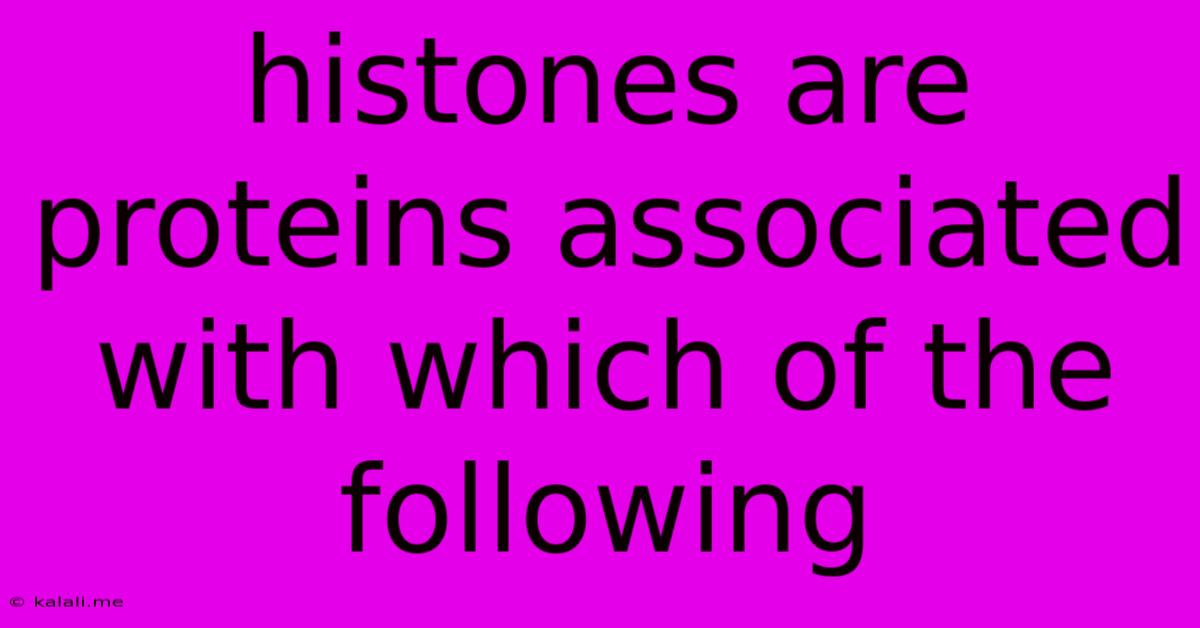Histones Are Proteins Associated With Which Of The Following
Kalali
Jun 16, 2025 · 3 min read

Table of Contents
Histones: The Protein Scaffolding of DNA
Histones are proteins that are absolutely fundamental to the structure and function of our genetic material, DNA. This article will delve into the specifics of histones, clarifying their association with DNA and explaining their crucial role in cellular processes. Understanding histones is key to understanding how our genes are regulated and expressed. This comprehensive guide will equip you with the knowledge necessary to grasp the intricate relationship between histones and DNA.
Histones are strongly associated with DNA, forming a complex called chromatin. This association is not incidental; it's a critical part of how our cells package and manage vast amounts of genetic information within the tiny confines of a cell nucleus. Think of histones as the spool around which the thread of DNA is wound. This compact packaging allows for efficient storage and protection of DNA, and also plays a key role in regulating gene expression.
The Structure of Chromatin: From Nucleosomes to Chromosomes
The basic unit of chromatin is the nucleosome. A nucleosome consists of approximately 146 base pairs of DNA wrapped around an octamer of histone proteins. This octamer is composed of two copies each of four core histone proteins: H2A, H2B, H3, and H4. These histones have a high proportion of positively charged amino acids (like lysine and arginine), which allows them to interact strongly with the negatively charged phosphate backbone of DNA.
Beyond the nucleosome, chromatin is further organized into higher-order structures, ultimately forming the chromosomes we see during cell division. The organization of chromatin is dynamic and changes depending on the cell's needs. This dynamic nature is crucial for gene regulation.
Histone Modifications and Gene Regulation: The Epigenetic Landscape
The story of histones doesn't end with their structural role. Histones are also subject to various post-translational modifications, such as acetylation, methylation, phosphorylation, and ubiquitination. These modifications occur on the "tails" of the histone proteins, extending outward from the nucleosome core.
These modifications alter the accessibility of DNA to transcriptional machinery. For example, histone acetylation generally loosens chromatin structure, making DNA more accessible for transcription and gene activation. Conversely, histone methylation can have different effects depending on the specific site and type of methylation; it can either activate or repress gene expression. This complex interplay of modifications creates what's known as the epigenetic landscape, which influences gene expression without altering the underlying DNA sequence.
Understanding these modifications is key to comprehending how cells regulate gene expression in response to internal and external signals. Research in this area is expanding rapidly, with implications for understanding and treating various diseases, including cancer.
Beyond the Core Histones: Histone Variants and Their Roles
While H2A, H2B, H3, and H4 are the core histones found in most nucleosomes, there are also histone variants. These variants can replace the canonical histones in specific locations within the genome, influencing chromatin structure and function in unique ways. For instance, the histone variant H2AX is involved in DNA repair, while other variants are associated with specific gene regulatory mechanisms. The study of histone variants adds another layer of complexity to the already fascinating world of histone biology.
In conclusion, histones are intimately associated with DNA, forming the structural basis of chromatin. Their modifications and the presence of histone variants play a critical role in regulating gene expression, highlighting their importance in cellular processes and human health. The ongoing research in this field continuously reveals new insights into the complex interplay between histones and the genome.
Latest Posts
Latest Posts
-
The Word Atom Comes From A Greek Word That Means
Jun 16, 2025
-
Henry Ford Is Noted For His Contributions To
Jun 16, 2025
-
An Inner Transition Metal With Seven 4f Electrons
Jun 16, 2025
-
Least Common Multiple Of 4 6 9
Jun 16, 2025
-
Are Secondary Storage Devices That Use Laser Technology
Jun 16, 2025
Related Post
Thank you for visiting our website which covers about Histones Are Proteins Associated With Which Of The Following . We hope the information provided has been useful to you. Feel free to contact us if you have any questions or need further assistance. See you next time and don't miss to bookmark.